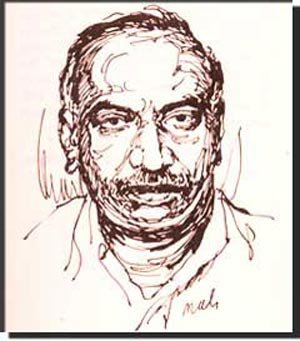
Kamraj was born on July 15, 1903, in a family of traders at Virudunagar. His real name was Kamakshi Kumaraswamy Nadar but was affectionately shortened to Raja by his mother, Sivakami Ammal. His father, Kumarswamy Nadar, was a coconut merchant. Kamaraj was enrolled at the local elementary school, the Nayanar Vidyalaya but was later shifted to the high school Kshatriya Vidyalaya.
Unfortunately his father died within a year of Kamaraj’s enrollment in school. Kamaraj’s mother sold all jewellery except her earrings and deposited the money with a local merchant and cared for the entire family on the monthly interest that the money earned.
Kamaraj was not a good student in school and dropped out when he was in the sixth grade. When he entered mainstream public life he felt handicapped and realized the importance of a good education. He educated himself during his periods of imprisonment and even learned English from his co-worker.
Kamaraj joined as an apprentice in his maternal uncle Karuppiah’s cloth shop after dropping out of school. He would slip out from the shop to join processions and attend public meetings.
At the age of 16, Kamaraj enrolled himself as full-time worker of the Congress. He participated in inviting speakers, organizing meetings and collecting funds for the party.
Kamaraj was arrested and sent to Alipore Jail for two years. He was twenty seven at the time of arrest and was released in 1931 following the Gandhi-Iriwn Pact. Kamaraj was arrested again in 1940 and sent to Vellore Jail while he was on his way to Wardha to get Gandhiji’s approval for a list of satyagrahis.
While still in jail, Kamaraj was elected Chairman to the Municipal Council. Nine months later upon his release, Kamaraj went straight to the Municipality and tendered his resignation from his post. He felt that “one should not accept any post to which one could not do full justice.”
Kamaraj was arrested once more in 1942 and sentenced to three years in the Amaravati prison for spreading propaganda material for Quit India movement initiated by Gandhiji. While in prison, Kamaraj read books and continued his self-education.
Kamaraj’s political guru and inspiration was S. Satyamurti, orator and parliamentarian. Both developed a deep friendship and complemented each others’ skills. So deep was Kamaraj’s devotion for Satyamurti that when India gained independence, he first went to Satyamurti’s house and hoisted the Indian flag there. On his election as Chief Minister, Kamaraj went to Satyamurti’s house and garlanded his photo and paid his respects to the leader’s widow.
On April 13, 1954, K. Kamaraj reluctantly became the Chief Minister of Madras. To everyone’s surprise, Kamaraj nominated C. Subramaniam and M. Bhakthavatsalam, who had contested his leadership, to the newly formed cabinet.
Under Kamaraj’s administration, a number of irrigation schemes were completed in record time. The Land Ceiling Act and the Tenancy Protection Act benefited small farmers and saved them from being exploited by landlords. Medium and small scale industries prospered in the midst of large industries making Madras one of the leaders in industrialization. Nehru complimented Kamaraj for making Madras (later renamed State of Tamil Nadu) the best administered State in India.”
Kamaraj remained Chief Minister for three consecutive terms. On October 2, 1963, he resigned to serve a greater purpose. Kamaraj noticed that the Congress party was slowly losing its vigour . He came up with a plan which was called the “Kamaraj Plan.” He proposed that all senior Congress leaders should resign form their posts and devote all their energy to the re-vitalization of the Congress. A number of Central and State ministers like Lal Bahadur Shastri, Jagjivan Ram, Morarji Desai and S.K. Patil followed suite and resigned from their posts. In 1964, Kamaraj was elected the President of the All India Congress and he successfully navigated the nation through the stormy years following Nehru’s death.
On October 2, 1975, Gandhi Jayanti, Kamaraj died. He was honored with the highest civilian honour, the Bharat Ratna, posthumously in 1976.

